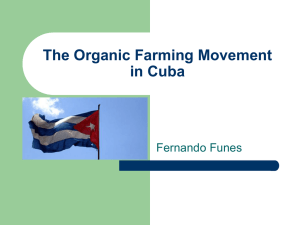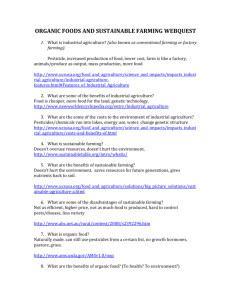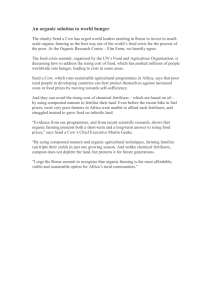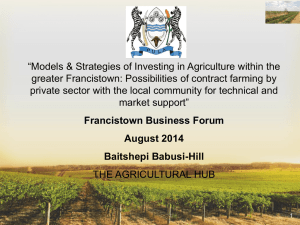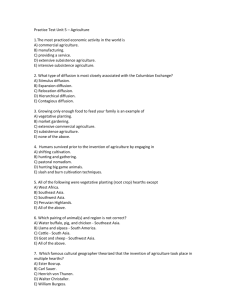Source file
advertisement
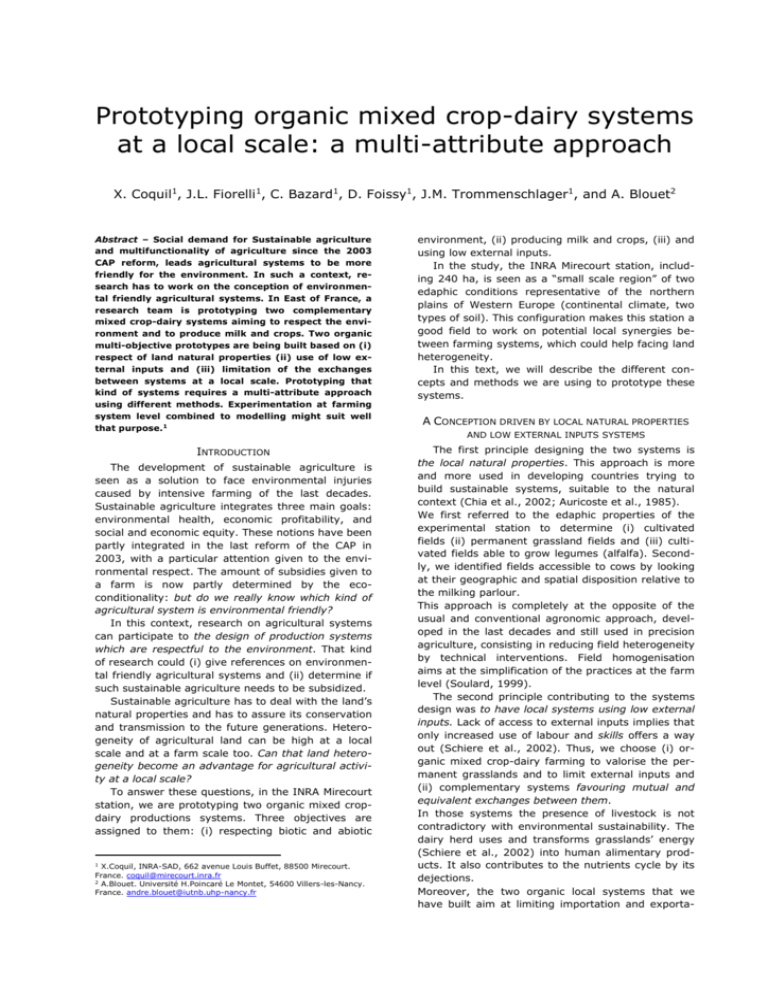
Prototyping organic mixed crop-dairy systems at a local scale: a multi-attribute approach X. Coquil1, J.L. Fiorelli1, C. Bazard1, D. Foissy1, J.M. Trommenschlager1, and A. Blouet2 Abstract – Social demand for Sustainable agriculture and multifunctionality of agriculture since the 2003 CAP reform, leads agricultural systems to be more friendly for the environment. In such a context, research has to work on the conception of environmental friendly agricultural systems. In East of France, a research team is prototyping two complementary mixed crop-dairy systems aiming to respect the environment and to produce milk and crops. Two organic multi-objective prototypes are being built based on (i) respect of land natural properties (ii) use of low external inputs and (iii) limitation of the exchanges between systems at a local scale. Prototyping that kind of systems requires a multi-attribute approach using different methods. Experimentation at farming system level combined to modelling might suit well that purpose.1 environment, (ii) producing milk and crops, (iii) and using low external inputs. In the study, the INRA Mirecourt station, including 240 ha, is seen as a “small scale region” of two edaphic conditions representative of the northern plains of Western Europe (continental climate, two types of soil). This configuration makes this station a good field to work on potential local synergies between farming systems, which could help facing land heterogeneity. In this text, we will describe the different concepts and methods we are using to prototype these systems. INTRODUCTION The first principle designing the two systems is the local natural properties. This approach is more and more used in developing countries trying to build sustainable systems, suitable to the natural context (Chia et al., 2002; Auricoste et al., 1985). We first referred to the edaphic properties of the experimental station to determine (i) cultivated fields (ii) permanent grassland fields and (iii) cultivated fields able to grow legumes (alfalfa). Secondly, we identified fields accessible to cows by looking at their geographic and spatial disposition relative to the milking parlour. This approach is completely at the opposite of the usual and conventional agronomic approach, developed in the last decades and still used in precision agriculture, consisting in reducing field heterogeneity by technical interventions. Field homogenisation aims at the simplification of the practices at the farm level (Soulard, 1999). The second principle contributing to the systems design was to have local systems using low external inputs. Lack of access to external inputs implies that only increased use of labour and skills offers a way out (Schiere et al., 2002). Thus, we choose (i) organic mixed crop-dairy farming to valorise the permanent grasslands and to limit external inputs and (ii) complementary systems favouring mutual and equivalent exchanges between them. In those systems the presence of livestock is not contradictory with environmental sustainability. The dairy herd uses and transforms grasslands’ energy (Schiere et al., 2002) into human alimentary products. It also contributes to the nutrients cycle by its dejections. Moreover, the two organic local systems that we have built aim at limiting importation and exporta- The development of sustainable agriculture is seen as a solution to face environmental injuries caused by intensive farming of the last decades. Sustainable agriculture integrates three main goals: environmental health, economic profitability, and social and economic equity. These notions have been partly integrated in the last reform of the CAP in 2003, with a particular attention given to the environmental respect. The amount of subsidies given to a farm is now partly determined by the ecoconditionality: but do we really know which kind of agricultural system is environmental friendly? In this context, research on agricultural systems can participate to the design of production systems which are respectful to the environment. That kind of research could (i) give references on environmental friendly agricultural systems and (ii) determine if such sustainable agriculture needs to be subsidized. Sustainable agriculture has to deal with the land’s natural properties and has to assure its conservation and transmission to the future generations. Heterogeneity of agricultural land can be high at a local scale and at a farm scale too. Can that land heterogeneity become an advantage for agricultural activity at a local scale? To answer these questions, in the INRA Mirecourt station, we are prototyping two organic mixed cropdairy productions systems. Three objectives are assigned to them: (i) respecting biotic and abiotic X.Coquil, INRA-SAD, 662 avenue Louis Buffet, 88500 Mirecourt. France. coquil@mirecourt.inra.fr 2 A.Blouet. Université H.Poincaré Le Montet, 54600 Villers-les-Nancy. France. andre.blouet@iutnb.uhp-nancy.fr 1 A CONCEPTION DRIVEN BY LOCAL NATURAL PROPERTIES AND LOW EXTERNAL INPUTS SYSTEMS tion from one to another. These limited local exchanges are costless in terms of energy and, if they are mutual and equivalent, they avoid unbalanced fertility transfers between the systems. That position is opposite to intensive dairy farming which uses high external importations like, for example, massive importations of soybean, leading to high energy expense, soil depletion in soybean exporting countries and causing environmental problems in importing countries. TWO COMPLEMENTARY PROTOTYPES Those principles have led to two organic dairy prototypes (Table 1): a Grassland farming system (GFS) and a Mixed-Crop Dairy System (MCDS). The GFS is made-up of permanent grasslands grazed by 37 dairy cows and the replacement heifers. Cows are overwintered in cubicles buildings and they are fed by maximising grazing (calving period takes place in late winter) in order to minimize straw, concentrates and energy requirements. The MCDS involves permanent grasslands and cultivated areas. Rotations of six or eight years, including a three year period of mixed grass and legumes cover, are conducted on cultivated areas. Forages are grazed or cut to feed the 60 cows and the replacement heifers. Calving period takes place in late summer in order to valorise all the conserved forages. Cows are overwintered on straw bedding to produce manure that will be spread on cultivated fields. Because housing is really long, straw needs are quite high, so crops are mostly cereals or associations of cereals and legumes. At the small region scale, milk production lasts all year long in spite of a single very short calving period in each system. The GFS prototype needs a minimum of cereals, as energetic concentrates, and straw which are produced on the MCDS. In exchange, the MCDS receive some manure and slurry from the GFS. The exchange is based on nitrogen and carbon contents. AGRICULTURAL SYSTEM EXPERIMENTATION COMBINED TO eight years. Decision rules are used to choose and homogenize agricultural operations used from one year to another on the systems. Those rules are created in a participative way with farmers, researchers, advisors and the experimental farm’s staff. Experimental approach will be completed by a multi-objective modelling approach, in order to explore different farming options as described by Ten Berge et al. (2000). These approaches are complementary (i) we can run protocols to understand and quantify a process in order to model it and (ii) we can test experimentally the prototype proposed by the model at the farm scale. The model will also be tested in different farming situations in commercial farms from the Lorraine region. A MULTI-OBJECTIVE APPROACH To prototype such production systems, a multiobjective approach is always necessary. It is a difficult exercise because even the rules defining the choice of the operating methods have to include the different objectives assigned to the system. For example, in such organic cropping systems, ploughing is an efficient practice for weed management but it enhanced mineralisation and it has a high energetic cost inducing a depressive influence on the environment. An alternative to Vereijken (1997) methodical approach is to use a multi-attribute model mixing empirical and scientific knowledge (Bohanec and Rajkovič, 1999). ACKNOWLEDGEMENT Thanks to all the staff from Mirecourt INRA experimental research centre and all our stakeholders. REFERENCES Auricoste, C., Deffontaines, J.P., Fiorelli, J.L., Langlet, A. and Osty, P.L. (1983). BTI 399/401:301-306 Bohanec, M. and Rajkovič,. V. (1999). Informatica. 23:487-491 MULTI-OBJECTIVE MODELLING To achieve such multi-objective approach, we have inspired ourselves from Vereijken methodical way of prototyping integrated and ecological arable farming systems (1997). We have declined the objectives and sub-objectives assigned to both systems by confronting the researcher’s and experimental farm Technical staff’s point of views. We are now defining holistic parameters with threshold values and methods to achieve them. Table 1. Two complementary organic dairy prototypes setup at the INRA Mirecourt station. Organic dairy prototypes GFS MCDS Cows* 37 60 Heifers* 55 90 Natural grasslands (ha) 74,5 45 Temporal grasslands (ha) 0 48,5 Crops (ha) 0 72 *Montbéliardes (50%) and Holstein Friesian (50%). These two theoretical prototypes are going to be tested on Mirecourt experimental farm for at least Chia, E., Dedieu, B., Deffontaines, J.P. and Dorado, G. (2002). Cahiers Agricultures. 11:333-341. Schiere, J.B., Ibrahim, M.N.M. and van Keulen, H. (2002). Agriculture Ecosystems & Environment. 90:139-153. Soulard, C. (1999). Les agriculteurs et la pollution des eaux. Proposition d’une géographie des pratiques. PhD Thesis. Paris I. Ten Berge, H.F.M., van Ittersum, M.K., Rossing, W.A.H., van de Ven, G.W.J., Scahns, J. and van de Sanden, P.A.C.M. (2000). European Journal of Agronomy. 13:263-277. Vereijken, P. (1997). European Journal of Agronomy. 7:235-250.
